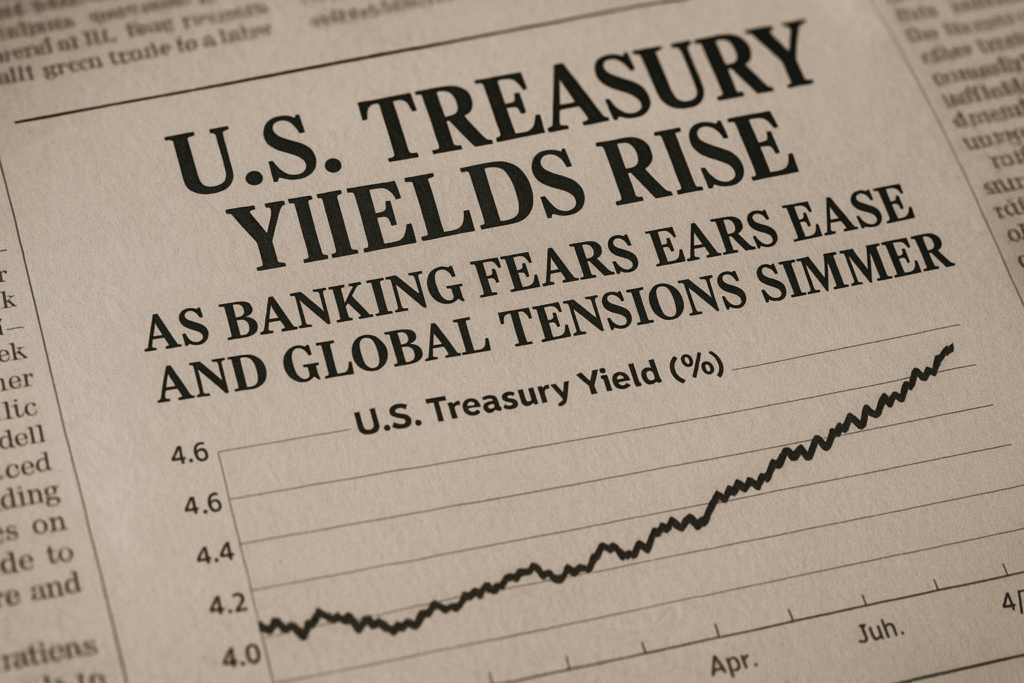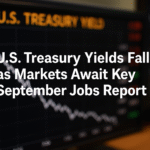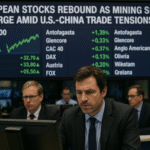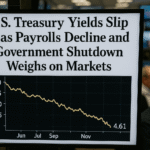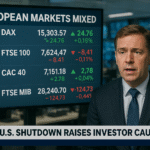By Harshit, WASHINGTON, D.C., 17 october, 2025 — 12:30 AM EDT
U.S. Treasury yields climbed on Friday as investors shook off mounting concerns about a potential credit crisis in the banking sector, following reassuring earnings from regional banks and a shift in sentiment around recent loan losses.
The 10-year Treasury yield rose 3 basis points to 4.005%, while the 2-year Treasury note also gained 3 basis points to 3.459%. The 30-year bond yield edged up 2 basis points to 4.602%. In the bond market, one basis point equals 0.01%, and yields move inversely to prices.
The uptick follows Thursday’s sharp move into safe-haven assets after concerns surfaced regarding potential hidden risks in private credit portfolios. However, fresh earnings reports and stabilizing market sentiment appear to have calmed investor nerves heading into the weekend.
Market Recovery After Banking Concerns
The rebound in yields reflects easing fears after midweek turbulence triggered by disclosures from U.S. regional lenders.
On Wednesday, Zions Bancorporation revealed a $50 million loss tied to two commercial loans, sparking fears that poorly managed or high-risk loans could be widespread across smaller banks. The anxiety deepened Thursday when Western Alliance Bancorporation disclosed that one of its borrowers had committed fraud.
The twin incidents prompted a brief selloff in financial stocks and a flight to safety as investors worried about the possibility of a broader private credit market crisis. But by Friday, markets were reassessing those fears. Analysts said the losses appeared manageable rather than systemic.
“While the developments raised eyebrows, these appear to be isolated issues rather than the start of a new credit contagion,” said Michael Dugan, senior strategist at Market Insight Partners. “Investors are realizing that most mid-tier banks have tightened lending standards considerably since early 2024.”
Regional Bank Earnings Restore Confidence
The improving sentiment was further buoyed by positive earnings from several regional lenders. Fifth Third Bancorp, for instance, reported a notable jump in quarterly profit, even as credit losses grew due to exposure to the bankrupt subprime auto lender Tricolor.
The strong performance suggested that while some lenders are taking hits from riskier segments of the market, broader financial stability remains intact.
“Earnings like these signal that credit quality remains resilient despite isolated shocks,” said Sarah McKenna, banking analyst at JPW Research. “It’s giving investors confidence that the sector can absorb minor losses without triggering a domino effect.”
By late morning, Treasury yields had fully recovered from Thursday’s dip, with investors gradually rotating back into risk assets.
Geopolitical Developments Add Global Uncertainty
While banking fears have eased, traders remain cautious as several international flashpoints weigh on the global outlook.
Fresh escalations in the U.S.-China trade war have rattled global markets, with tariffs on semiconductor and automotive exports intensifying supply chain uncertainty. Meanwhile, Washington’s renewed diplomatic push in Eastern Europe is drawing close attention.
President Donald Trump said Thursday he will meet Russian President Vladimir Putin in Budapest, Hungary, for new talks aimed at brokering peace in the Ukraine War. The announcement came as Trump confirmed plans to meet Ukrainian President Volodymyr Zelenskyy later this week.
“We are closer to peace than we have been in years,” Trump said in a social media post. “Both sides have expressed willingness to negotiate.”
Investors are watching these geopolitical shifts closely, as any progress—or breakdown—in negotiations could influence energy prices, global trade flows, and, consequently, inflation expectations.
Domestic Pressures: The Government Shutdown Drag
Back home, the ongoing government shutdown has entered its third week, stalling major federal operations and delaying key economic reports. Analysts say the absence of regular data releases from the Bureau of Labor Statistics and Commerce Department has made it harder for investors to gauge the economy’s true condition.
“Without reliable data, markets are essentially flying blind,” said David Lin, chief economist at Horizon Analytics. “Bond traders are relying on anecdotal information and sentiment rather than hard numbers.”
The lack of clarity has added an unusual layer of volatility to the Treasury market, though Friday’s movement suggests investors are regaining confidence that the economy’s underlying fundamentals remain sound.
Bond Market Overview
| Treasury Type | Yield | Change (bps) |
|---|---|---|
| 1-Month | 4.071% | +1.1 |
| 3-Month | 3.932% | -2.2 |
| 6-Month | 3.803% | -0.4 |
| 1-Year | 3.566% | +1.8 |
| 2-Year | 3.457% | +3.1 |
| 10-Year | 4.005% | +3.0 |
| 30-Year | 4.602% | +2.0 |
Short-term yields remain relatively stable, while long-dated bonds are showing incremental increases, suggesting a gradual steepening of the yield curve. Analysts say this may reflect improving economic sentiment and diminished recession fears.
Outlook
With the Federal Reserve maintaining a cautious stance and inflation appearing to stabilize, investors are increasingly focused on global developments and fiscal policy uncertainty in Washington.
The combination of easing banking concerns, resilient corporate earnings, and diplomatic momentum abroad has helped the bond market regain footing. However, economists warn that prolonged government gridlock or renewed credit stress could quickly reverse those gains.
“For now, it’s a relief rally,” said strategist Dugan. “But the market remains one shock away from renewed volatility.”

